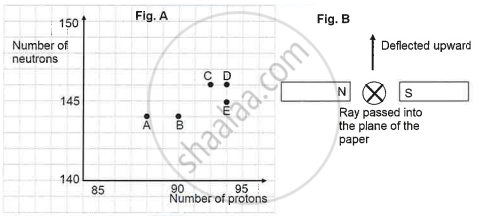Advertisements
Advertisements
प्रश्न
Name and state the rule to determine the direction of magnetic field around a straight current-carrying conductor.
उत्तर
Maxwell’s right-hand thumb rule is used to determine the direction of magnetic field around a straight current-carrying conductor.
According to this rule, if we grasp a current-carrying wire in our right hand so that our thumb points in the direction of the current, the direction in which our fingers encircle the wire will give the direction of magnetic field lines around the wire.
When thumb points upwards, the curled fingers are anticlockwise. So, the direction of magnetic field lines is anticlockwise.
When thumb points downwards, the curled fingers are clockwise. So, the direction of magnetic field lines is clockwise.
APPEARS IN
संबंधित प्रश्न
The magnetic field inside a long straight solenoid-carrying current ______.
State qualitatively the effect of inserting an iron core into a current-carrying solenoid.
Fill in the following blank with suitable words:
For a current-carrying solenoid, the magnetic field is like that of a ...........
What is a solenoid? Draw a sketch to show the magnetic field pattern produced by a current-carrying solenoid.
The force exerted on a current-carrying wire placed in a magnetic field is zero when the angle between the wire and the direction of magnetic field is:
45°
60°
90°
180°
A horizontal wire carries a current as shown in Figure below between magnetic poles N and S:

Is the direction of the force on the wire due to the magnet:
(a) in the direction the current
(b) vertically downwards
(c) opposite to the current direction
(d) vertically upwards
State two ways to increase the speed of rotation of a D.C. motor.
The following diagram shows two parallel straight conductors carrying the same current. Copy the diagram and draw the pattern of the magnetic field lines around them showing their directions. What is the magnitude of the magnetic field at a point 'X' which is equidistant from the conductors? Give justification for your answer.

State under what conditions force acting on a current carrying conductor which is freely suspended in a magnetic field can be Zero.
|
The graph (fig A) illustrates the correlation between the number of protons (x-axis) and the number of neutrons (y-axis) for elements A, B, C, D, and E in the periodic table. These elements are denoted by the letters rather than their conventional symbols. When the element C, depicted in the graph, undergoes radioactive decay, it releases radioactive rays. When these rays are directed into the plane of the paper in the presence of a magnetic field, as indicated in the fig B, they experience deflection, causing them to move upwards.
|
Name the law used to identify the radioactive radiation emitted by the element.

